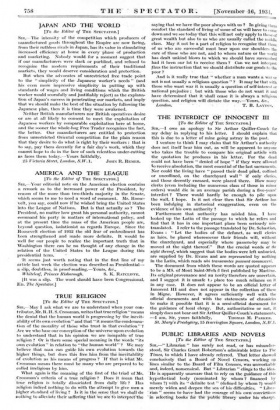THE INTERDICT OF INNOCENT III
[To the Editor of THE SPECTATOR.] owe an apology to Sir Arthur Quiller-Couch for my delay in replying to his letter. I should explain that this is due to a letter of mine going astray in the post. I venture to think I may claim that Sir Arthur's authority does not itself bear him out, as will be apparent to anyone who takes the trouble to compare 'his original article with the quotation he produces in his letter. For the dead could not have been " denied of hope " if they were allowed to receive absolution, the most essential of the last sacraments. Nor could the living have " passed their dead piled, coffined
or uncoffined, on the churchyard wall if only clerics, and those decently encased, were placed there. How many clerks (even including the numerous class of those in minor orders) would die in an average parish during a five-years' interdict ? There would hardly be enough to pile upon the wall, -I hope. Is it not clear then that Sir Arthur has been indulging in rhetorical exaggeration, even on the evidence of his own authority ?
Furthermore that authority has misled him. I have looked up the. Latin of the• passage to which he refers and find that it has in one important place been seriously mis- translated. I refer to the passage translated by Dr. Sebastian, Evans : " Let the bodies of the defunct, as well clerics as laics, be placed wheresoever their friends will, without the churchyard, and especially where passers-by may be moved at the sight thereof." But the crucial words at the sight thereof, which 'suggest that the bodies were left unburied, are supplied by Dr. Evans and are represented by nothing in the Latin, which reads ubi transeuntes possunt commoveri.
The document from which these words are quoted appears to be a MS. of Mont Saint-Mich31 first published by Marten. Its original provenance and au .hority therefore are uncertain, and I suggest it is' unsafe LI place too much reliance on it in any case. It does not appear to be an official letter of Innocent III and does not appear in the collection of these in Migne. However, it agrees sufficiently well with the official documents and with the statements of chronicles to make it possible that it is a semi-official document for the guidance of local clergy. But, authoritative or not, it simply does not bear out Sir Arthur Quiller-Couch's statements, —I am, Sir, yours faithfully, THOMAS M. PARKER. St. Mary's Presbytery, 15 Barrington Square, London, N. W.1.






































 Previous page
Previous page